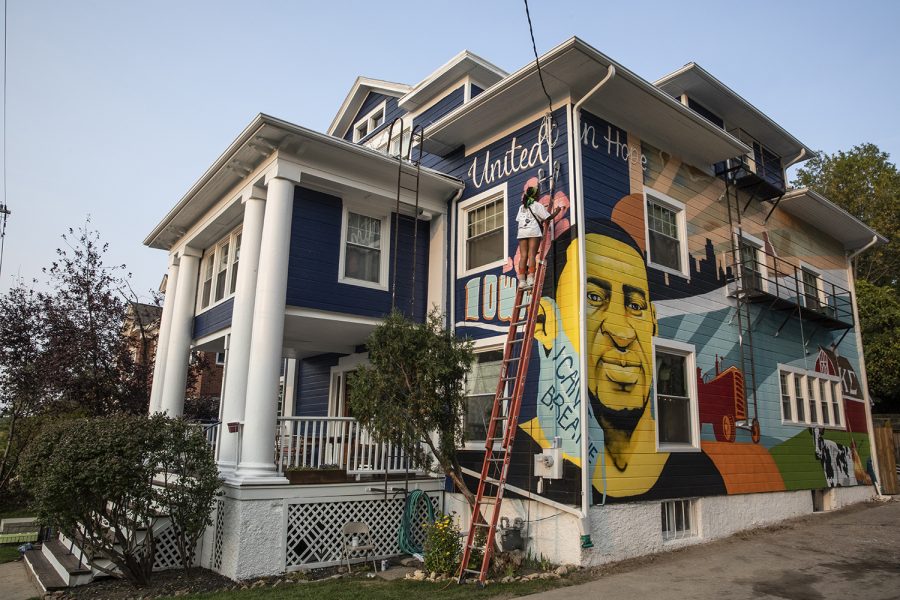Opinion | Take some time to acknowledge Iowa City’s public art
Public art is a powerful way to connect the community and shed light on social justice issues.
The mural entitled “Falling Upwards” fills the south side of a home on Dubuque Street in Iowa City, Iowa on Friday, September 25, 2020. The mural, painted by Defy Studios of Minneapolis was commissioned by property owner Sam Stelter, a former University of Iowa student and Kappa-Sigma Beta-Rha member, who saw the mural as an opportunity to create conversation of individual experiences and the power of community.
December 1, 2021
Walking downtown, colorful murals can be seen lining the brick antique buildings. One of my favorites is the Queen Fox mural by artist Ryan Bentzinger. The warm shades of orange, red, and white blend together in streaks creating a very whimsical image of a fox in nature inspired by Iowa’s scenery. The mural stretches across the alley with an ombre of blue and black filling the background of the image.
There are numerous striking examples of public art in Iowa City that aim to bring the community together through publicly expressing values and artistry. Although people don’t typically look at the state of Iowa and think about what it has to offer within the visual arts, Iowa City has a rich display of public art we should all appreciate.
Many of the beautiful murals in Iowa City come through The Iowa City Mural project, which works to bring artists into the community by helping them find spaces to create their work for the public to see.
Outside of the Iowa City Mural project, there have been other impactful community art projects like the portrait of George Floyd on North Dubuque Street and the ‘Oracles of Iowa City’ outside of the Capital Street Parking Ramp, each done using myriad bright colors to bring light to injustice. Powerful images like these are striking to look at and have the power to push dialogues and that might otherwise not happen.
In addition to the many murals, graffiti is another powerful public art form that can shed light on injustices and increase a sense of community.
Following the footsteps of protesters marching for justice after the murder of George Floyd came an abundance of graffiti art coating the walls of downtown Iowa City. Phrases like “ACAB,” “F12,” and “Silence is Violence” reflected the rage and grief many were facing. These phrases also forced dialogue surrounding the injustices Black people face.
With the display of anti-police graffiti art, some people were left angry, and others hopeful. However, both emotions were because art played an integral role in pushing dialogues about injustice.
Public art is not only valuable in creating a sense of community and shining a light on important issues, it can also be a valuable tool for economic development. For example, well-lit communities with public art attract more people into the community and tend to create safer communities. Additionally, arts can generate tax revenue. Typically for every dollar invested in the arts $6 is generated in tax revenue.
Although there are economic benefits to community art, it’s important to recognize how gentrification can play a role in the erasure of art as well as what art or artists have a platform to access communities with art. An example of this happening can be seen in Bushwick Village as property owners took advantage of public art to incentivize potential tenants.
Next time you are perusing the streets of downtown Iowa City, take some time to appreciate the graffiti, murals, and plaques that are scattered around.
Columns reflect the opinions of the authors and are not necessarily those of the Editorial Board, The Daily Iowan, or other organizations in which the author may be involved.














